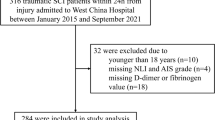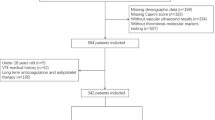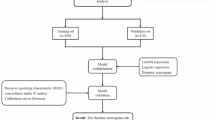Abstract
Study design
Cross-sectional study.
Objectives
Deep vein thrombosis (DVT) presents a significant risk of complication in patients with spinal cord injury (SCI), necessitating accurate screening methods. While the Caprini Risk Assessment Model (Caprini RAM) has seen extensive use for DVT screening, its efficacy remains under scrutiny.
Setting
First Affiliated Hospital of China University of Science and Technology.
Methods
We created and evaluated three nomograms for their effectiveness in DVT screening. Model 1 incorporated variables such as age, D-dimer level, red blood cell (RBC) counts, platelet counts, presence of type 2 diabetes mellitus, high blood pressure, mode and level of injury, degree of impairments, and Caprini scores. Model 2 was derived from Caprini scores alone, and Model 3 focused on independent risk factors. We assessed these models using the area under the curve (AUC) of the receiver operating characteristic (ROC), calibration curves, and decision curve analysis (DCA), employing bootstrap resampling tests (500 iterations) to determine their accuracy, discriminative ability, and clinical utility. Internal validation was performed on a separate cohort. Nomogram was established with well-fitted calibration curves for model 1, 2 and 3(AUC = 0.808, 0.751 and 0.797; 95%CI = 0.76–0.86, 0.70–0.80 and 0.75–0.84; respectively), indicating model 1 outperformed the others in prediction DVT risk, followed by model 3 and 2. These findings were consistent in the validation cohort, with DCA further corroborating our conclusions.
Conclusion
A nomogram integrating clinical data with Caprini RAM provides a superior option for DVT screening in SCI patients within rehabilitation settings, outperforming Caprini RAM.
Similar content being viewed by others
Log in or create a free account to read this content
Gain free access to this article, as well as selected content from this journal and more on nature.com
or
Data availability
Data and materials used in this study are available upon reasonable request from the first and corresponding author. Additionally, the original data can be accessed through the following link: https://osf.io/ax27c/?view_only=c1f4ded911174c0f9e62cdf5ee89326a.
References
Godat LN, Haut ER, Moore EE, Knudson MM, Costantini TW. Venous thromboembolism risk after spinal cord injury: A secondary analysis of the CLOTT study. J Trauma Acute Care Surg. 2023;94:23–9.
Wang ZM, Zou P, Yang JS, Liu TT, Song LL, Lu Y, et al. Epidemiological characteristics of spinal cord injury in Northwest China: a single hospital-based study. J Orthop Surg Res. 2020;15:214.
Sertic F, Diagne D, Chavez L, Richards T, Berg A, Acker M, et al. Mid-term outcomes with the use of extracorporeal membrane oxygenation for cardiopulmonary failure secondary to massive pulmonary embolism. Eur J Cardiothorac Surg. 2020;58:923–31.
Mackiewicz-Milewska M, Cisowska-Adamiak M, Szymkuć-Bukowska I, Sakwińska K, Domarecka I, Lewandowska A, et al. Intramuscular Hematomas in Patients Receiving Prophylaxis or Anticoagulant Treatment after Spinal Cord Injury (SCI)-A Rare Complication: Description of Seven Cases and a Literature Analysis. Biomedicines. 2023;11:1142.
Bo H, Li Y, Liu G, Ma Y, Li Z, Cao J, et al. Assessing the Risk for Development of Deep Vein Thrombosis among Chinese Patients using the 2010 Caprini Risk Assessment Model: A Prospective Multicenter Study. J Atheroscler Thromb. 2020;27:801–8.
Lui A, Park C, Chryssikos T, Radabaugh H, Patel A, Aabedi AA, et al. Safety and comparative efficacy of initiating low-molecular-weight heparin within 24 h of injury or surgery for venous thromboembolism prophylaxis in patients with spinal cord injury: a prospective TRACK-SCI registry study. Neurosurg Focus. 2023;55:E17.
Wei B, Zhou H, Liu G, Zheng Y, Zhang Y, Hao C, et al. Risk factors for venous thromboembolism in patients with spinal cord injury: A systematic review and meta-analysis. J Spinal Cord Med. 2023;46:181–93.
Lv B, Wang H, Li W, Han G, Liu X, Zhang C, et al. Admission Prevalence and Risk Factors of Deep Vein Thrombosis in Patients with Spinal Cord Injury Complicated with Cervical Fractures. Clin Appl Thromb Hemost. 2022;28:1–7.
Hazeltine MD, Scott EM, Dorfman JD. An abbreviated Caprini model for VTE risk assessment in trauma. J Thromb Thrombolysis. 2022;53:878–86.
Broen K, Scholtes B, Vossen R. Predicting the need for further thrombosis diagnostics in suspected DVT is increased by using age adjusted D-dimer values. Thromb Res. 2016;145:107–8.
Wang C, Yu X, Wang T, Ding M, Ran L. D-dimer/fibrinogen ratio for the prediction of deep venous thrombosis after traumatic spinal cord injury. Spinal Cord. 2023;61:447–52.
Slajus B, Brailovsky Y, Darwish I, Fareed J, Darki A. Utility of Blood Cellular Indices in the Risk Stratification of Patients Presenting with Acute Pulmonary Embolism. Clin Appl Thromb Hemost. 2021;27:10760296211052292.
Mackiewicz-Milewska M, Kroszczynski A, Cisowska-Adamiak M, Pyskir J, Rosc D, Hagner W. Hemostatic parameters in patients with spinal cord injury in subacute and chronic phase of the rehabilitation. J Spinal Cord Med. 2021;44:782–8.
Lai J, Wu S, Fan Z, Jia M, Yuan Z, Yan X, et al. Comparative study of two models predicting the risk of deep vein thrombosis progression in spinal trauma patients after operation. Clin Neurol Neurosurg. 2024;236:108072.
Cronin M, Dengler N, Krauss ES, Segal A, Wei N, Daly M, et al. Completion of the Updated Caprini Risk Assessment Model (2013 Version). Clin Appl Thromb Hemost. 2019;25:1076029619838052.
Roberts TT, Leonard GR, Cepela DJ. Classifications In Brief: American Spinal Injury Association (ASIA) Impairment Scale. Clin Orthop Relat Res. 2017;475:1499–504.
Yakusheva O, Bang JT, Hughes RG, Bobay KL, Costa L, Weiss ME. Nonlinear association of nurse staffing and readmissions uncovered in machine learning analysis. Health Serv Res. 2022;57:311–21.
Ou H, Yao Y, He Y. Missing Data Imputation Method Combining Random Forest and Generative Adversarial Imputation Network. Sens (Basel, Switz). 2024;24:1112.
Steyerberg E, Vergouwe Y. Towards better clinical prediction models: seven steps for development and an ABCD for validation. Eur Heart J. 2014;35:1925–31.
Lei Z, Li J, Wu D, Xia Y, Wang Q, Si A, et al. Nomogram for Preoperative Estimation of Microvascular Invasion Risk in Hepatitis B Virus-Related Hepatocellular Carcinoma Within the Milan Criteria. JAMA Surg. 2016;151:356–63.
Bertsimas D, Margonis GA, Tang S, Koulouras A, Antonescu CR, Brennan MF, et al. An interpretable AI model for recurrence prediction after surgery in gastrointestinal stromal tumour: an observational cohort study. EClinicalMedicine. 2023;64:102200.
Fitzgerald M, Saville BR, Lewis RJ. Decision curve analysis. Jama. 2015;313:409–10.
Alba A, Agoritsas T, Walsh M, Hanna S, Iorio A, Devereaux P, et al. Discrimination and Calibration of Clinical Prediction Models: Users’ Guides to the Medical Literature. JAMA. 2017;318:1377–84.
Tadesse T, Kedir H, Fentie A, Abiye A. Venous Thromboembolism Risk and Thromboprophylaxis Assessment in Surgical Patients Based on Caprini Risk Assessment Model. Risk Manag Healthc Policy. 2020;13:2545–52.
Krauss ES, Segal A, Dengler N, Cronin M, Pettigrew J, Simonson BG. Utilization of the Caprini Score for Risk Stratification of the Arthroplasty Patient in the Prevention of Postoperative Venous Thrombosis. Semin Thromb Hemost. 2022;48:407–12.
Sun W, Ai D, Yao Y, Ren K, Lu J, Sun H, et al. The application of Caprini Risk Assessment Model in evaluation of deep vein thrombosis for patients with end-stage osteoarthritis before arthroplasty. BMC Musculoskelet Disord. 2022;23:767.
Goehner D, Hafner A, Paddock E, Evans D, Schabauer A. Hospital Venous Thromboembolism Prevention: A Year-Long Case Based Caprini Score Risk Analysis with Findings Suggesting Optimal Care. S D Med. 2020;73:404–9.
Lin Y, Zeng Z, Lin R, Zheng J, Liu S, Gao X. The Caprini thrombosis risk model predicts the risk of PICC-related upper extremity venous thrombosis in cancer patients. J Vasc Surg Venous Lymphat Disord. 2021;9:1151–8.
Gold P, Ng T, Coury J, Garbarino L, Sodhi N, Mont M, et al. Can the Caprini score predict thromboembolism and guide pharmacologic prophylaxis after primary joint arthroplasty? J Orthop. 2020;21:345–9.
Hayssen H, Sahoo S, Nguyen P, Mayorga-Carlin M, Siddiqui T, Englum B, et al. Ability of Caprini and Padua risk-assessment models to predict venous thromboembolism in a nationwide Veterans Affairs study. J Vasc Surg Venous Lymphat Disord. 2024;12:101693.
Krauss ES, Cronin M, Dengler N, Simonson BG, Enker P, Segal A. Lessons Learned: Using the Caprini Risk Assessment Model to Provide Safe and Efficacious Thromboprophylaxis Following Hip and Knee Arthroplasty. Clin Appl Thromb Hemost. 2020;26:1076029620961450.
Wu Z, Li K, Zhu Q, Li H, Tang Z, Wang Z. Application value of D-dimer testing and Caprini risk assessment model (RAM) to predict venous thromboembolism (VTE) in Chinese non-oncological urological inpatients: a retrospective study from a tertiary hospital. Transl Androl Urol. 2020;9:1904–11.
Wang H, Lv B, Li W, Wang S, Ding W. Diagnostic Performance of the Caprini Risk Assessment Model Combined With D-Dimer for Preoperative Deep Vein Thrombosis in Patients With Thoracolumbar Fractures Caused by High-Energy Injuries. World Neurosurg. 2022;157:e410–e416.
Zhang W, Sun R, Hu X, Chen Z, Lai C. Caprini risk assessment model combined with D-dimer to predict the occurrence of deep vein thrombosis and guide intervention after laparoscopic radical resection of colorectal cancer. World J Surg Oncol. 2023;21:299.
Liu H, Li L, Zhao Z. Values of Caprini Risk Assessment Scale and D-Dimer for Predicting Venous Thromboembolism During Puerperium. Int J Women Health. 2024;16:47–53.
Cui S, Chen S, Li H, Ke L, Liu Y, Jiang R, et al. Risk factors for venous thromboembolism and evaluation of the modified Caprini score in patients undergoing lung resection. J Thorac Dis. 2020;12:4805–16.
Byrnes JR, Wolberg AS. Red blood cells in thrombosis. Blood. 2017;130:1795–9.
Faes C, Ilich A, Sotiaux A, Sparkenbaugh EM, Henderson M, et al. Red blood cells modulate structure and dynamics of venous clot formation in sickle cell disease. Blood. 2019;133:2529–41.
Mackiewicz-Milewska M, Cisowska-Adamiak M, Pyskir J, Świątkiewicz I. Usefulness of D-dimer and Ultrasonography Screening for Detecting Deep Vein Thrombosis in Patients with Spinal Cord Injury Undergoing Rehabilitation. J Clin Med. 2021;10:689.
Jiao Y, Mu X. Coagulation parameters correlate to venous thromboembolism occurrence during the perioperative period in patients with spinal fractures. J Orthop Surg Res. 2023;18:928.
Li XL, Wang Q, Yin HJ, Wang YH, Cao J, Fan L. Chronic Application of Low-Dose Aspirin Affects Multiple Parameters of Three Blood Cellular Types and Antithrombin Activity: A 1:1:1 Propensity Score Matching Analysis. J Cardiovasc Pharmacol. 2021;77:115–21.
de Campos Guerra JC, Mourão MA, França CN, da Rosa CD, Burattini MN. Impact of coagulation in the development of thromboembolic events in patients with spinal cord injury. Spinal Cord 2014;52:327–32.
Matsumoto S, Suda K, Iimoto S, Yasui K, Komatsu M, Ushiku C, et al. Prospective study of deep vein thrombosis in patients with spinal cord injury not receiving anticoagulant therapy. Spinal Cord 2015;53:306–9.
Avila M, Bhogadi SK, Nelson A, Hosseinpour H, Ditillo M, Akl M, et al. The long-term risks of venous thromboembolism among non-operatively managed spinal fracture patients: A nationwide analysis. Am J Surg 2023;225:1086–90.
Furlan JC, Fehlings MG. Cardiovascular complications after acute spinal cord injury: pathophysiology, diagnosis, and management. NeurosurgFocus. 2008;25:E13.
Wang L, Ma X, Chen Y, Gao S, Pan W, Chen J, et al. Factors influencing DVT formation in sepsis. Thromb J. 2024;22:11.
Elsamadicy AA, Koo AB, Kundishora AJ, Chouairi F, Lee M, Hengartner AC, et al. Impact of patient and hospital-level risk factors on extended length of stay following spinal fusion for adolescent idiopathic scoliosis. J Neurosurg Pediatr. 2019;24:1–7.
Zhang P, Zhang Z, Zhong J, Zheng X, Zhou J, Sun W. Cardiovascular diseases consequences of type 1, type 2 diabetes mellitus and glycemic traits: A Mendelian randomization study. Diab Res Clin Pract. 2024;208:111094.
Green D. Prevention of thromboembolism after spinal cord injury. Semin Thromb Hemost. 1991;17:347–50.
Acknowledgements
We would like to thank Tingting Zhang, CuicuiChang, Tingting Bao, Nanzu Chengjiang, Liai Sun and Lina Ma for collecting the data. During the preparation of this work the authors used Chatgpt 4.0 in order to improve the English language writing. After using this tool, the authors reviewed and edited the content as needed and takes full responsibility for the content of the publication.
Funding
This study was supported by the National Natural Science Foundation of China (81972146; 82002393; 82272599), 1.3.5 project for disciplines of excellence, West China Hospital, Sichuan University (ZYGD23014), and the National Key R&D Program of China (2023YFC3603800; 2023YFC3603802). The funders played no role in the design, conduct, or reporting of this study.
Author information
Authors and Affiliations
Contributions
JLZ wrote the main manuscript text and designed the study, statistical analyzed and interpreted the data. CW organized for collecting the data. CQH supervised the study. YHY planned the project. The authors all read and approved the final manuscript.
Corresponding author
Ethics declarations
Competing interests
The authors declare no competing interests.
Patient consent
Informed consent was waived due to the retrospective nature of the study, coinciding with the ethical requirements and waiver from the ethics committee.
Ethics approval and consent to participate
We certify that all applicable institutional and governmental regulations concerning the ethical use of human data were followed during the course of this research. This study was performed in line with the principles of the Declaration of Helsinki. And, this study has received approval from the Ethics Committee of First Affiliated Hospital of the University of Science and Technology of China (Anhui Provincial Hospital); approval number: 2020-RE-008.
Additional information
Publisher’s note Springer Nature remains neutral with regard to jurisdictional claims in published maps and institutional affiliations.
Supplementary information
Rights and permissions
Springer Nature or its licensor (e.g. a society or other partner) holds exclusive rights to this article under a publishing agreement with the author(s) or other rightsholder(s); author self-archiving of the accepted manuscript version of this article is solely governed by the terms of such publishing agreement and applicable law.
About this article
Cite this article
Zhang, J., Wang, C., He, C. et al. Development and validation of a novel screening tool for deep vein thrombosis in patients with spinal cord injury: A five-year cross-sectional study. Spinal Cord 62, 523–531 (2024). https://doi.org/10.1038/s41393-024-01014-4
Received:
Revised:
Accepted:
Published:
Issue date:
DOI: https://doi.org/10.1038/s41393-024-01014-4



